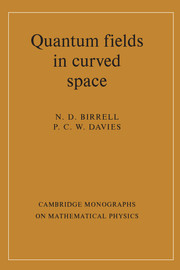Book contents
- Frontmatter
- Contents
- Preface
- Preface to the paperback edition
- Conventions and abbreviations
- 1 Introduction
- 2 Quantum field theory in Minkowski space
- 3 Quantum field theory in curved spacetime
- 4 Flat spacetime examples
- 5 Curved spacetime examples
- 6 Stress-tensor renormalization
- 7 Applications of renormalization techniques
- 8 Quantum black holes
- 9 Interacting fields
- References
- Index
3 - Quantum field theory in curved spacetime
Published online by Cambridge University Press: 05 August 2012
- Frontmatter
- Contents
- Preface
- Preface to the paperback edition
- Conventions and abbreviations
- 1 Introduction
- 2 Quantum field theory in Minkowski space
- 3 Quantum field theory in curved spacetime
- 4 Flat spacetime examples
- 5 Curved spacetime examples
- 6 Stress-tensor renormalization
- 7 Applications of renormalization techniques
- 8 Quantum black holes
- 9 Interacting fields
- References
- Index
Summary
The basic formalism of quantum field theory is generalized to curved spacetime in this chapter, in a straightforward way. The discussion is preceded by a very brief summary of pseudo-Riemannian geometry. The treatment is in no way intended to be complete, and we refer the reader to Weinberg (1972), Hawking & Ellis (1973), or Misner, Thorne & Wheeler (1973) for further details. Readers unfamiliar with conformal transformations and Penrose conformal diagrams are advised to read §3.1 carefully, however.
The basic generalization of the particle concept to curved spacetime is readily accomplished. What is not so easy is the physical interpretation of the formalism so developed. There has, in fact, been a certain amount of controversy over the meaning – and meaningfulness – of the particle concept when a background gravitational field is present. In some cases, such as for static spacetimes, the concept seems well defined, while in others (e.g. spacetimes that admit closed timelike world lines or do not everywhere possess Cauchy surfaces) the notion of particle can seem hopelessly obscure. We restrict consideration to ‘well-behaved’ spacetimes, and do not embark upon a philosophical discourse about the meaning of particles. Instead we relate the formalism directly to what an actual particle detector might be expected to register in the particular quantum state of interest. It is in this concrete operational sense that we define particles in curved spacetime. Although this approach has been studied before, we give the most developed treatment of particle detectors so far.
- Type
- Chapter
- Information
- Quantum Fields in Curved Space , pp. 36 - 88Publisher: Cambridge University PressPrint publication year: 1982



